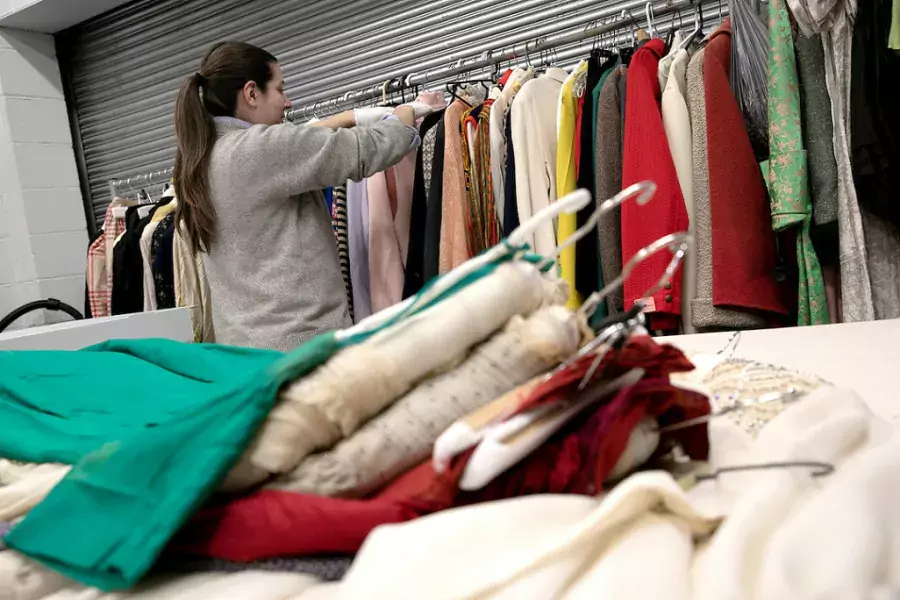
Three things we learned in CCAD’s new museum management course
While this semester sees the debut of CORE3801, its subject matter is anything but new.
Titled Museum Management, Interpretation & Collection Care Special Topics, this new course features hands-on experience with the registration and management of artifacts in the newly acquired CCAD Historic Fashion Collection.
Adjunct Instructor Marlise Schoeny, also assistant curator of The Ohio State University’s Historic Costume & Textiles Collection, says, “We focus quite a bit on the day-to-day management of a collection.” Students write donor agreements, file acquisition documents, and complete the accession and deaccession process, while also exploring the more cerebral functions of a museum, such as learning professional standards or participating in current debates about museum ethics and cultural ownership.
Here are three interesting things we learned while visiting the class.

1. CCAD students have some seriously cool ideas for museums.
At the beginning of the semester, Schoeny tasked the course’s 11 students (mostly Fine Arts and Art History majors) to envision a dream museum they’d start if resources weren’t an issue.
In the coursework since, they’ve shaped, refined, and analyzed their “museum” through the lens of each week’s topic. They’ve written individual mission statements for their museums; developed exhibition ideas and thought about what they’d curate for that exhibition; outlined the kind of space, storage conditions, and manpower they’d need to run the museum; and even considered what types of artifacts or artworks they might collect—or not collect.
“There’s a tendency to say everything is valuable,” Schoeny says. “This exercise has students take a step back and consider space constraints or whether there is even the security necessary to take care of this object. What will it need in terms of conservation? Conservation is a whole other bucket of fish.”
For example, one student’s museum aims to display and collect art that has only ever existed on the internet. This has led to class discussion about how preserving a digital art museum’s artifacts would require a unique set of resources. You would need a budget for things technology to ensure the art files remained viewable with museum technology, even if the technology used to play those files becomes less available (think how boring a vinyl museum would be without a record player).
“The nice thing about [the class] is it gives us case studies to consider and dissect,” Schoeny says. “It gets us deeper into discussions and makes us ask how a concept, like writing a collections policy, applies in each student’s particular museum.”
Some other awesome museum ideas from this semester’s class: a museum for literary works that have instigated massive cultural or social change (think: The Jungle by Upton Sinclair); a museum dedicated to the interrelationship between local flora/fauna and native art; and an outdoor statuary and flower garden museum that considers the changing ideals of feminine beauty through sculpture and landscape.

2. Hands on is key to an impactful museum experience.
As part of their semester-long museum planning, students in this course also learn about best practices to engage the public, both inside and outside the museum. They discuss how one-on-one interactions on a museum visit have proven to improve the guest’s experience and they’ve discussed how to appeal to new and loyal museum audiences alike.
For example, one student’s museum project is a place that displays modern art for children. Schoeny says this brought up a group discussion of what kinds of mediums they could display, how hands on the young guests could be, and more.
The students are seeing museum collections first-hand as part of the coursework and hearing from the professionals in charge. Schoeny says she’s hoping for visits from a conservator and fundraising specialist this semester, and she’s tapped her own professional network of colleagues—such as Pamela Theodotou, media specialist with the Byrd Polar and Climate Research Center—to speak to the students about their work.

Photos taken by Ty Wright for CCAD.
3. There is a typography, font size, and hanging position that almost guarantees an artwork’s label is more likely to get read by a museum-goer.
We can tell you this: The most important information, or the information you most want a viewer to retain, should always be toward the top of the label’s content. As for the pro tips of best font size, typeface, and where to hang an art label in correlation to the piece it’s associated with (particularly helpful tips for Fine Arts students who might hang or write their own labels in a gallery)—well, we don’t want to spoil all the surprises. The course will be available again next fall for sophomores, juniors, and seniors of any major.
Explore CCAD’s course catalog and learn more about the CCAD Historic Fashion Collection and Studio Art with an Emphasis in the History of Art & Visual Culture.
Post date
November 12, 2018